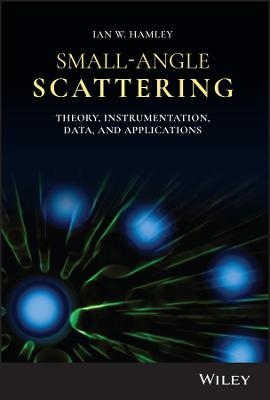
Small-Angle Scattering
John Wiley & Sons Inc (Verlag)
978-1-119-76830-2 (ISBN)
Small-Angle Scattering: Theory, Instrumentation, Data, and Applications provides authoritative coverage of both small-angle X-ray scattering (SAXS), small-angle neutron scattering (SANS) and grazing incidence small-angle scattering (GISAS) including GISAXS and GISANS. This single-volume resource offers readers an up-to-date view of the state of the field, including the theoretical foundations, experimental methods, and practical applications of small-angle scattering (SAS) techniques including laboratory and synchrotron SAXS and reactor/spallation SANS.
Organized into six chapters, the text first describes basic theory, instrumentation, and data analysis. The following chapters contain in-depth discussion on various applications of SAXS and SANS and GISAXS and GISANS, and on specific techniques for investigating structure and order in soft materials, biomolecules, and inorganic and magnetic materials. Author Ian Hamley draws from his more than thirty years’ experience working with many systems, instruments, and types of small-angle scattering experiments across most European facilities to present the most complete introduction to the field available. This book:
Presents uniquely broad coverage of practical and theoretical approaches to SAXS and SANS
Includes practical information on instrumentation and data analysis
Offers useful examples and an accessible and concise presentation of topics
Covers new developments in the techniques of SAXS and SANS, including GISAXS and GISANS
Small-Angle Scattering: Theory, Instrumentation, Data, and Applications is a valuable source of detailed information for researchers and postgraduate students in the field, as well as other researchers using X-ray and neutron scattering to investigate soft materials, other nanostructured materials and biomolecules such as proteins.
Ian W. Hamley, PhD, is Diamond Professor of Physical Chemistry at the University of Reading, UK. He has more than 30 years of experience in using both SAXS and SANS, with more than 400 papers, many including SAXS and SANS data from a range of systems with diverse applications. Professor Hamley is the author of several books including Introduction to Peptide Science, Block Copolymers in Solution, and Introduction to Soft Matter, and is the editor of Developments in Block Copolymer Science and Technology, and co-editor of Nanoscale Science and Technology.
Preface ix
1 Basic Theory 1
1.1 Introduction 1
1.2 Wavenumber and Scattering Amplitude 2
1.3 Intensity for Anisotropic and Isotropic Systems and Relationships to Pair Distance Distribution and Autocorrelation Functions 3
1.4 Guinier Approximation 7
1.5 Form and Structure Factors 8
1.6 Structure Factors 11
1.7 Form Factors 26
1.8 Form and Structure Factors for Polymers 36
References 41
2 Data Analysis 45
2.1 Introduction 45
2.2 Pre-Measurement Sample Concentration and Polydispersity Measurements 46
2.3 Overview: Data Reduction Pipeline 46
2.4 Corrections for Sample Transmission and Others 48
2.5 Background Corrections 49
2.6 Detector Corrections, Mask Files, and Integration 51
2.7 Anisotropic Data 54
2.8 Calibration of q Scale 54
2.9 Absolute Intensity Calibration 56
2.10 Absorption 58
2.11 Smearing Effects 59
2.12 Solution SAXS Data Checks 60
2.13 Porod Regime 67
2.14 Kratky Plots 68
2.15 Zimm Plots 70
2.16 Invariant and Related Information Content From SAS Measurements 72
2.17 Form Factor Fitting 73
2.18 SAS Software 80
References 80
3 Instrumentation for SAXS and SANS 87
3.1 Introduction 87
3.2 Synchrotron Facilities 88
3.3 Neutron Scattering Facilities 88
3.4 Synchrotron SAXS Instrumentation 91
3.5 Laboratory SAXS Instrumentation 99
3.6 SANS Instrumentation 101
3.7 Ultra-Small-Angle Scattering Instruments 104
3.8 Standard Sample Environments – SAXS 106
3.9 Standard Sample Environments – SANS 109
3.10 Standard Sample Environments – GISAS 109
3.11 Microfocus SAXS and WAXS 110
3.12 Specialized Sample Environments 111
References 127
4 Applications and Specifics of SAXS 137
4.1 Introduction 137
4.2 Production of X-Rays 139
4.3 Scattering Processes for X-Rays 142
4.4 Atomic Scattering Factors 144
4.5 Anomalous SAXS and SAXS Contrast Variation 145
4.6 BioSAXS: Solution SAXS from Biomacromolecules, Especially Proteins 147
4.7 Solution SAXS from Multi-Domain and Flexible Macromolecules 154
4.8 Solution SAXS from Multi-Component Systems – Biomolecular Assemblies 160
4.9 Protein Structure Factor SAXS 161
4.10 SAXS (and WAXS) Studies of Soft Matter Systems 163
4.11 SAXS and WAXS From Semicrystalline Polymers 164
4.12 Lipid Phases: Electron Density Profile Reconstruction 168
4.13 SAXS Studies of Peptide and Lipopeptide Assemblies 171
4.14 SAXS Studies of the Structure Factor of Colloids 173
4.15 SAXS and SAXS/WAXS Studies of Biomaterials 177
4.16 Fast Time-Resolved SAXS 182
References 187
5 Applications and Specifics of SANS 197
5.1 Introduction 197
5.2 Production of Neutrons 198
5.3 Differential Scattering Cross-Section 199
5.4 Scattering Lengths 200
5.5 SANS Data Reduction Considerations 202
5.6 Contrast Variation 203
5.7 Single Molecule Scattering from Mixtures of Protonated and Deuterated Molecules 215
5.8 SANS from Labelled Polymers 217
5.9 Kinetic SANS Using Labelled Mixtures 222
5.10 Ultra-Small-Angle Sans (USANS) 223
5.11 SANS and USANS (AND SAXS and USAXS) Studies on Porous Structures 224
5.12 SANS on Magnetic Materials 227
5.13 Spin-Echo SANS (SESANS) 232
5.14 Complementary SAXS AND SANS 233
References 233
6 Grazing-Incidence Small-Angle Scattering 241
6.1 Introduction 241
6.2 Basic Quantities: Definition of Angles, Refractive Index, and Scattering Length Density 242
6.3 Characteristic Scans 245
6.4 The Distorted Wave Born Approximation 252
6.5 Data Analysis 256
6.6 Experimental Examples of GISAS Data 257
6.7 Experimental Examples of GIWAXS/GIXD Data 265
References 269
Index 273
| Erscheinungsdatum | 23.04.2021 |
|---|---|
| Verlagsort | New York |
| Sprache | englisch |
| Maße | 155 x 229 mm |
| Gewicht | 590 g |
| Themenwelt | Naturwissenschaften ► Chemie |
| Technik ► Maschinenbau | |
| ISBN-10 | 1-119-76830-6 / 1119768306 |
| ISBN-13 | 978-1-119-76830-2 / 9781119768302 |
| Zustand | Neuware |
| Haben Sie eine Frage zum Produkt? |
aus dem Bereich


